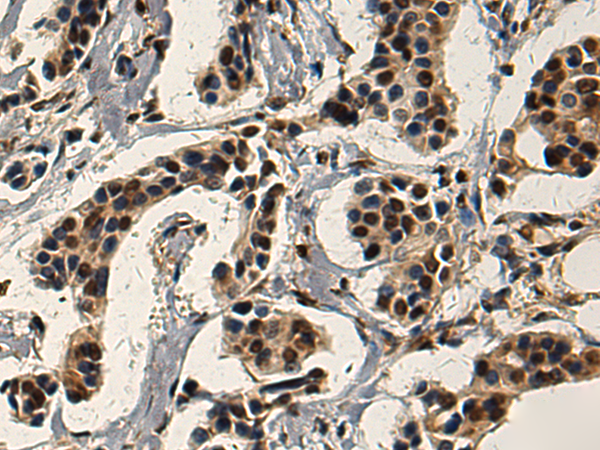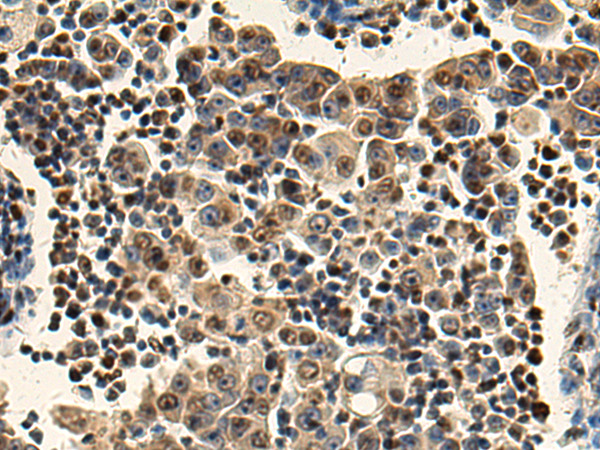

| WB | 咨询技术 | Human,Mouse,Rat |
| IF | 咨询技术 | Human,Mouse,Rat |
| IHC | 1/200-1/400 | Human,Mouse,Rat |
| ICC | 技术咨询 | Human,Mouse,Rat |
| FCM | 咨询技术 | Human,Mouse,Rat |
| Elisa | 1/5000-1/10000 | Human,Mouse,Rat |
| Aliases | RBT1 |
| Host/Isotype | Rabbit IgG |
| Antibody Type | Primary antibody |
| Storage | Store at 4°C short term. Aliquot and store at -20°C long term. Avoid freeze/thaw cycles. |
| Species Reactivity | Human, Mouse |
| Immunogen | Fusion protein of human SERTAD3 |
| Formulation | Purified antibody in PBS with 0.05% sodium azide and 50% glycerol. |
+ +
以下是关于SERTAD3抗体的3篇参考文献及其摘要概括:
1. **文献名称**:*SERTAD3 promotes hepatocellular carcinoma progression by regulating p53-mediated cell cycle process*
**作者**:Li, Y., et al.
**摘要**:该研究通过免疫组化(使用SERTAD3抗体)和功能实验发现,SERTAD3在肝细胞癌中高表达,通过抑制p53通路促进细胞周期进程和肿瘤生长。
2. **文献名称**:*SERTAD3 as a novel oncogene activates AKT/mTOR signaling pathway in colorectal cancer*
**作者**:Wang, J., et al.
**摘要**:研究利用SERTAD3抗体进行Western blot和免疫荧光,揭示SERTAD3通过激活AKT/mTOR信号通路促进结直肠癌细胞增殖和转移。
3. **文献名称**:*The role of SERTAD3 in DNA damage response and chemoresistance*
**作者**:Zhang, L., et al.
**摘要**:通过免疫沉淀(SERTAD3抗体)和基因沉默实验,证明SERTAD3通过调控DNA损伤修复蛋白的稳定性,增强肿瘤细胞对化疗药物的抵抗。
以上研究均涉及SERTAD3抗体在分子机制探索中的应用,涵盖癌症进展、信号通路及治疗抵抗等领域。
**Background of SERTAD3 Antibody**
SERTAD3 (SERTA domain-containing protein 3), also known as TRIP-Br3. is a member of the SERTA domain-containing protein family, which plays roles in transcriptional regulation and cell cycle control. It interacts with key regulators, such as E2F transcription factors and cyclin-dependent kinases (CDKs), influencing cell proliferation, apoptosis, and tumorigenesis. SERTAD3 is implicated in cancer progression, with studies showing its overexpression in various malignancies, including colorectal, breast, and liver cancers, where it correlates with poor prognosis and therapeutic resistance.
The SERTAD3 antibody is a critical tool for detecting and quantifying SERTAD3 protein expression in research. It enables the investigation of SERTAD3's functional roles, subcellular localization, and interaction partners via techniques like Western blotting, immunohistochemistry (IHC), and immunofluorescence (IF). Commercially available antibodies are typically validated for specificity and sensitivity, often targeting conserved regions of the protein. Recent studies highlight its potential as a biomarker for cancer diagnosis or a therapeutic target, driving interest in developing high-affinity antibodies for mechanistic and clinical studies. Understanding SERTAD3's regulatory networks through antibody-based assays remains vital for unraveling its contributions to cellular pathways and disease pathology.
×